Bifold Kitchen Doors – Buyer’s Guide
Table of Contents
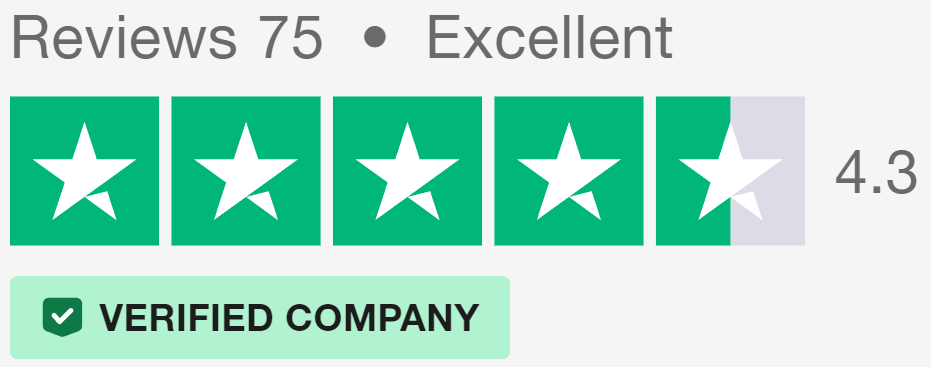
In recent years, British homeowners have shown growing interest in bifold kitchen doors. These versatile fixtures offer a fresh approach to kitchen design, blending functionality with style. Whether you’re renovating an existing space or planning a new build, understanding the ins and outs of bifold kitchen doors is crucial for making an informed decision.
What Are Bifold Kitchen Doors?
Bifold kitchen doors consist of multiple panels that fold against each other when opened. Unlike traditional hinged doors or sliding options, they accordion to one or both sides of the doorway. This unique design allows for a wide opening, connecting spaces in a way that conventional doors can’t match.
How They Work
The operation of bifold kitchen doors is straightforward yet ingenious. Each panel is connected by hinges, allowing the door to fold like a concertina. When you push or pull the lead panel, the others follow suit, neatly stacking to one side or splitting to both sides of the frame.
Track Systems
A crucial component of bifold doors is the track system. Mounted at the top and sometimes the bottom of the frame, these tracks guide the door panels as they open and close. High-quality tracks ensure smooth movement, reducing the effort needed to operate even large door setups.
Configuration Options
Bifold kitchen doors offer flexibility in their configuration. You can choose from various panel numbers and sizes to suit your specific space. Some common arrangements include:
- Two-panel doors for smaller openings
- Three or four-panel systems for medium-sized spaces
- Five or more panels for expansive kitchen-dining areas
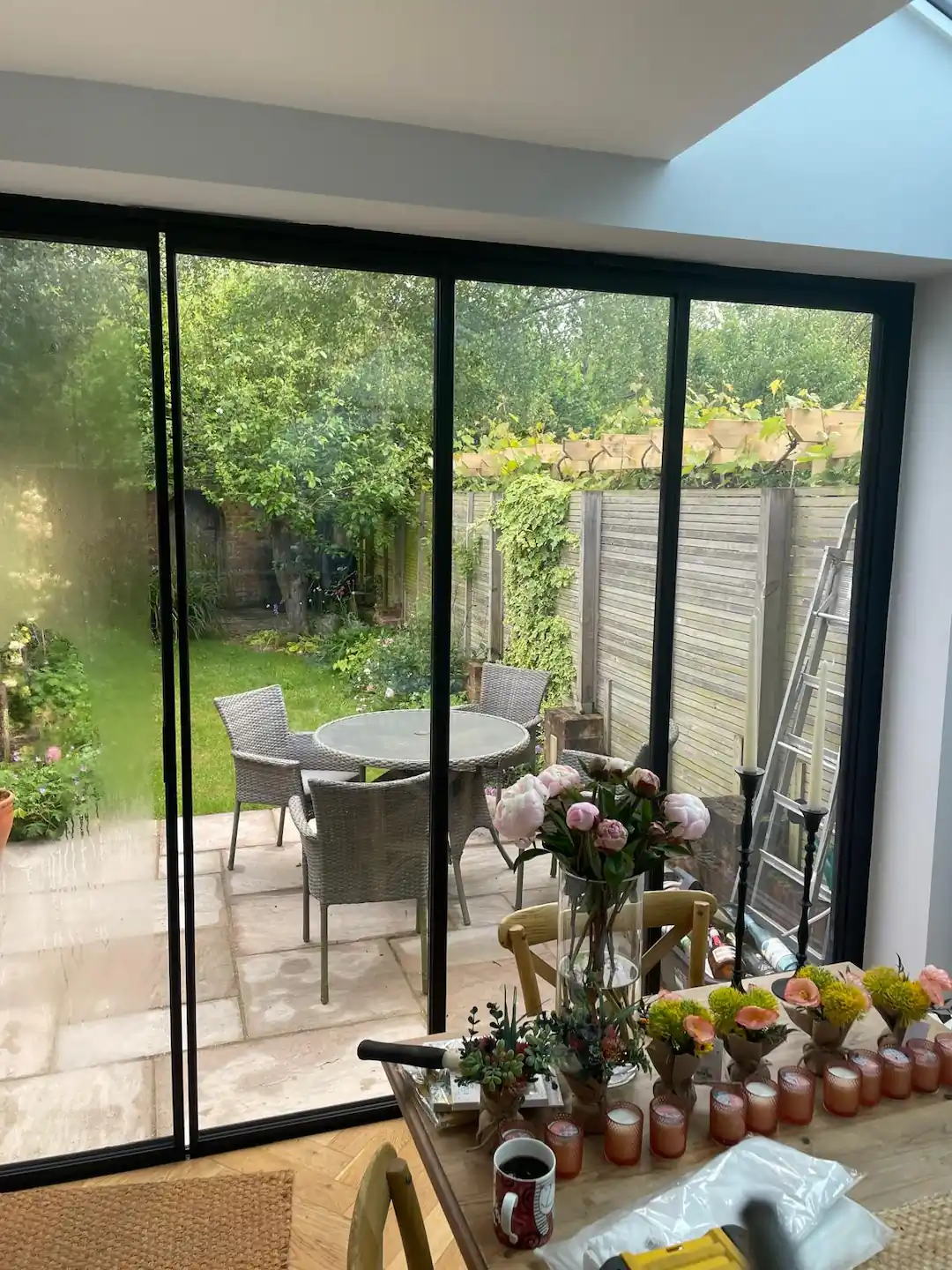
Materials Used
The choice of material for your bifold kitchen doors can impact their look, durability, and maintenance requirements. Here are some popular options:
Timber
Wood bifold doors bring warmth and character to a kitchen. Oak, pine, and mahogany are common choices, each offering unique grain patterns and colours. While beautiful, timber doors require regular maintenance to protect against moisture and temperature changes.
Aluminium
Lightweight yet strong, aluminium bifold doors are a modern option. They resist corrosion and require minimal upkeep, making them ideal for busy households. Aluminium frames can be powder-coated in various colours to match your kitchen’s palette.
uPVC
Unplasticised Polyvinyl Chloride (uPVC) doors offer a budget-friendly alternative. They’re low-maintenance and provide good insulation. While not as visually striking as timber or aluminium, uPVC doors come in a range of finishes, including wood-grain effects.
Benefits of Bifold Kitchen Doors
Bifold kitchen doors have gained popularity among British homeowners for good reason.
Space Efficiency and Flexibility
One of the primary appeals of bifold kitchen doors is their space-saving design. Unlike traditional swing doors that require clearance to open fully, bifold doors fold neatly against the wall. This feature is particularly valuable in compact kitchens where every centimetre counts. The extra room gained can be used for additional storage, appliances, or simply to create a more open feel.
Bifold doors also excel as flexible room dividers. When closed, they create distinct spaces, allowing you to separate your kitchen from dining or living areas. Open them up, and you instantly create a larger, unified space. This adaptability is particularly useful for entertaining or when you need to keep an eye on children while cooking.
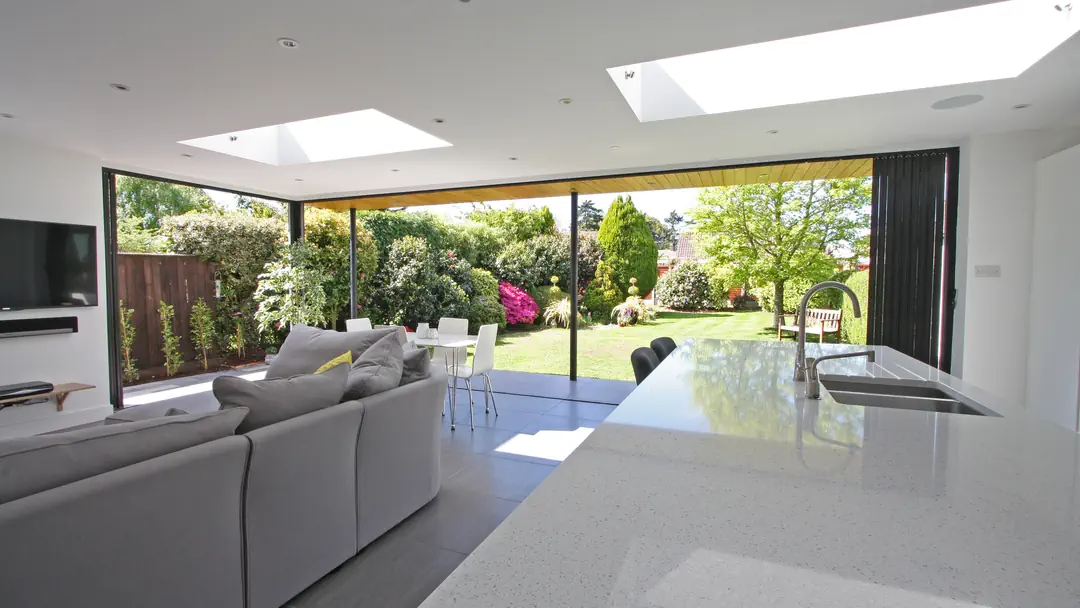
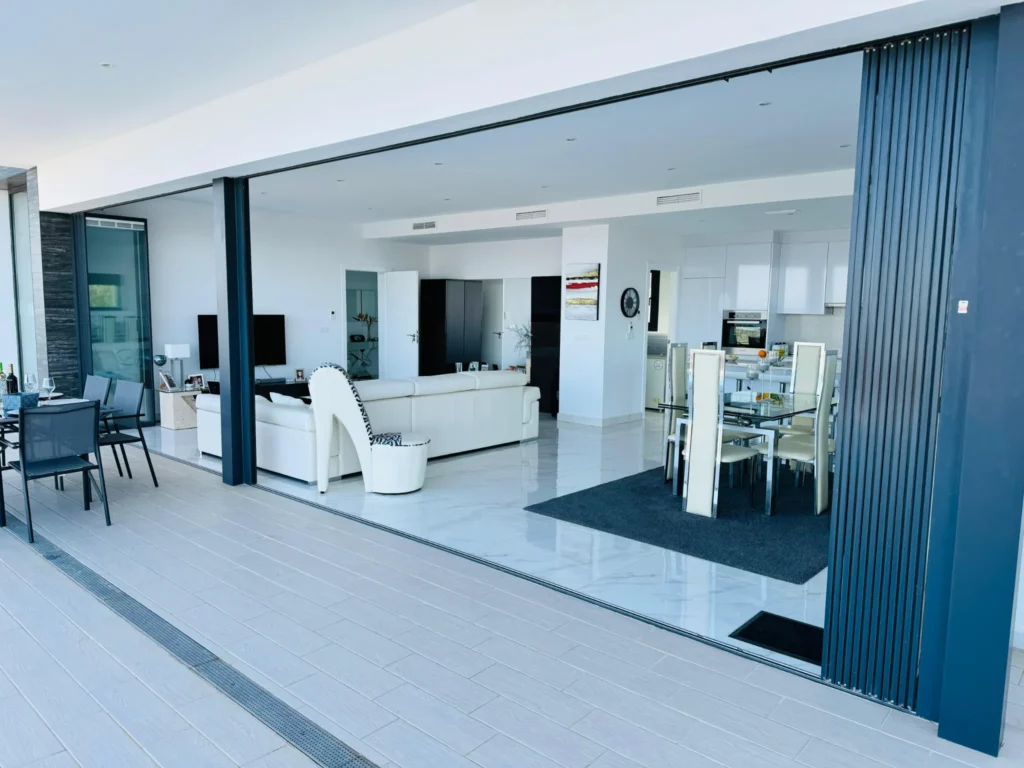
Improved Light and Airflow
The design of bifold kitchen doors can really alter the atmosphere of your cooking space. By replacing solid walls or traditional doors with bifold options, you invite more natural light into your kitchen. This increased brightness can make the space feel larger and more inviting, while also reducing the need for artificial lighting during daylight hours.
Cooking often generates heat, steam, and odours. Bifold doors, when fully opened, create a wide aperture that allows for efficient air circulation. This improved airflow helps keep your kitchen comfortable and odour-free, especially during summer months or when preparing pungent dishes.
Versatile Kitchen Layouts
For kitchens that open onto a garden or patio, external kitchen bifold doors create a smooth link between indoor and outdoor areas. This connection is perfect for summer barbecues or al fresco dining, allowing you to move freely between cooking and entertaining spaces.
The trend towards open plan living aligns perfectly with bifold kitchen doors. By opening the doors, you can create a spacious, sociable area that combines kitchen, dining, and living spaces. Close them when you need to contain cooking smells or create a cosier atmosphere.
Unlike sliding doors that typically open from one side, bifolding doors offer multiple configuration options. You can choose to open them from the centre, from one end, or even have them stack to one side. This variety allows you to tailor the opening to suit different occasions or weather conditions.
What to Consider Before Buying
Before investing in bifold kitchen doors, it’s crucial to weigh several factors to ensure they’re the right choice for your home.
Kitchen Size and Layout
The size and layout of your kitchen play a big role in determining whether bi folding doors are suitable. In a small open plan kitchen with bifold doors, these fixtures can maximise space and create a sense of openness. However, you’ll need to ensure there’s enough room for the doors to fold without obstructing walkways or work areas.
For those planning a kitchen extension with bifold doors, consider how the new space will flow into existing areas. The placement of bifold doors can make a big difference to the functionality and feel of your extended kitchen.
Internal vs External Use
While many homeowners think of bi fold doors for external use, kitchen bifold interior doors are equally effective. Internal bifold doors can separate a kitchen from a dining area or living room, offering flexibility in how you use your space.
If you’re considering exterior bifold doors, factor in additional considerations such as weatherproofing and security. External bifold doors need to withstand various weather conditions while maintaining energy efficiency.
Budget
Kitchen bifold doors come in a range of prices, influenced by factors such as size, material, and customisation. Set a realistic budget, keeping in mind that while bifold doors may be more expensive upfront than traditional doors, they can add value to your home and improve your living experience.
Remember to factor in installation costs, which can vary depending on whether you’re fitting the doors in an existing opening or as part of a new build or extension.
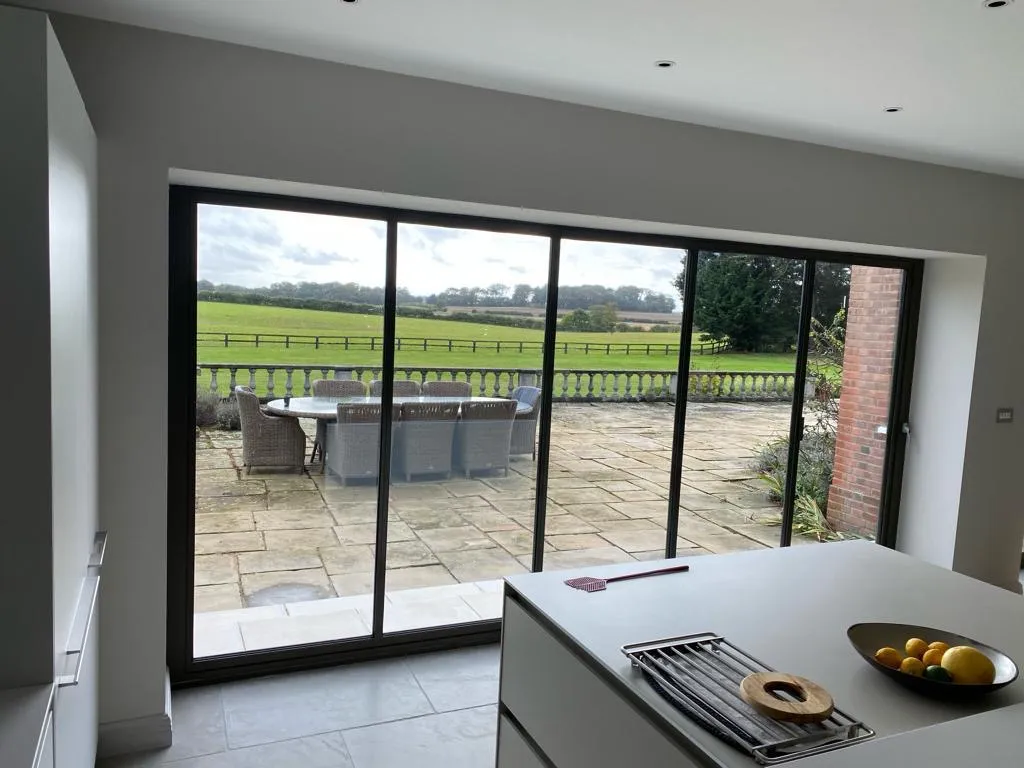
Made to Measure Options
Every kitchen is unique, and off-the-shelf solutions may not always fit perfectly. Many manufacturers offer made to measure bifold doors, ensuring a perfect fit for your specific space. While custom options may cost more, they can be worth the investment for a seamless look and optimal functionality.
Frame vs Frameless Options
When choosing kitchen bifold doors, you’ll need to decide between framed and frameless designs. Frameless bifold doors offer a sleek, modern aesthetic with maximum glass area, ideal for maximising light and views. However, framed options provide more structural support and may be necessary in certain installations.
Installation Requirements
Consider the structural requirements for installing bifolding doors in your kitchen. You’ll need a sturdy supporting beam above the opening to bear the weight of the doors. In some cases, additional reinforcement may be necessary.
Also, think about the flooring. The track system for bifold doors needs to be perfectly level for smooth operation. If you’re installing on an existing floor, ensure it’s even or be prepared for some levelling work.
Types of Kitchen Bifold Doors
Bifold kitchen doors come in various styles and configurations to suit different needs and preferences.
Number of Panels
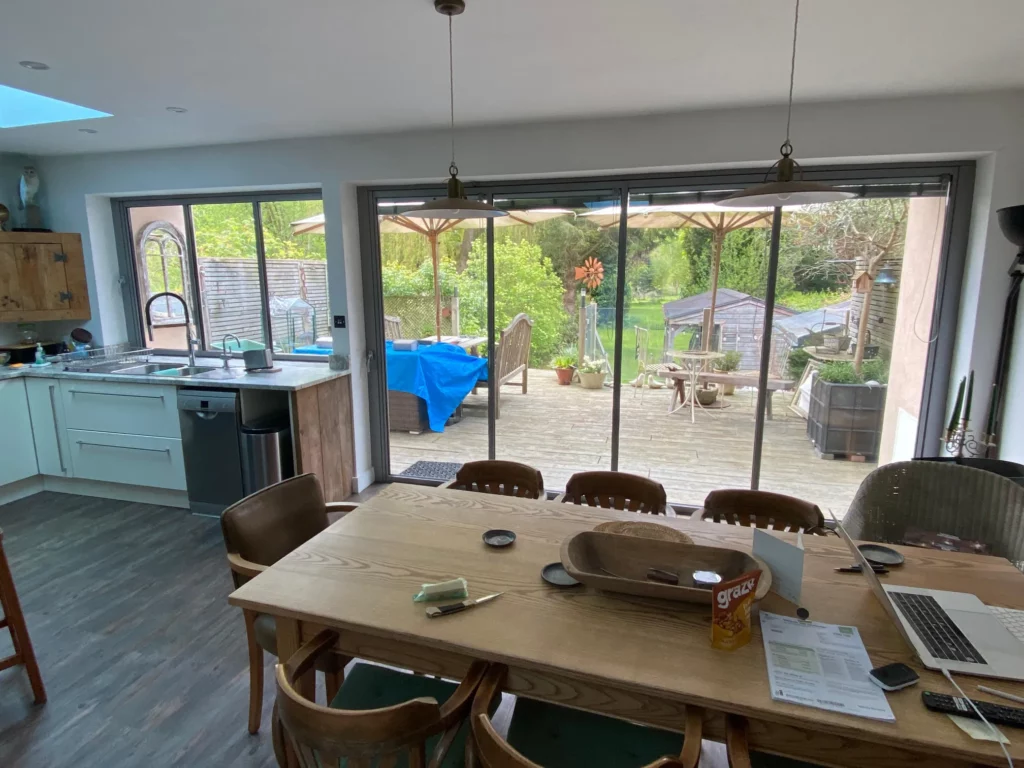
The number of panels in your bifold door system depends on the width of your opening and your desired look.
Two-panel doors are suitable for smaller openings, typically up to 1.5 meters wide. These are often used for pantries or as room dividers in compact kitchens.
Three or four-panel systems are common for medium-sized openings. They offer a good balance between functionality and aesthetics, allowing for a wide opening when fully folded.
For larger kitchen extensions or open-plan spaces, five or more panels can span wider openings, creating a dramatic effect when opened fully.
Opening Configurations
Bifold doors offer flexibility in how they open and stack:
- Inward or outward opening: Choose based on your kitchen layout and available space.
- Left or right-handed: The main opening panel can be on either side, depending on your preference and kitchen design.
- Centre opening: For larger systems, doors can open from the middle, folding to both sides.
Frame Materials
The choice of frame material affects both the look and performance of your kitchen bifold doors.
Timber frames bring warmth and character to a kitchen. They’re versatile in design but require regular maintenance to prevent warping or swelling in humid conditions.
Aluminium frames are lightweight yet strong. They’re ideal for larger door systems and offer slim sightlines, maximising glass area and light transmission.
uPVC frames are cost-effective and low-maintenance. While not as slim as aluminium, they provide good insulation and come in various finishes, including wood-grain effects.
Glass Options
Clear glass maximises light and views but offers little privacy.
Frosted or textured glass provides privacy while still allowing light through.
Double or triple glazing improves insulation, reducing heat loss and noise transmission.
Low-E (low emissivity) glass helps control temperature, reflecting heat back into the room during winter and reducing solar gain in summer.
Choosing the Right Style
Selecting the right style of kitchen bifold doors is vital for creating a cohesive look in your home. The doors should complement your kitchen’s design while meeting your needs.
Matching Your Kitchen Decor
When choosing bi folding doors for kitchens, consider your existing decor. In a traditional kitchen, timber frames with panel detailing might be appropriate. For a modern space, sleek aluminium frames with large glass panels could be the perfect fit.
Colour is another important factor. Many manufacturers offer a range of finishes for both frames and hardware. In an open plan kitchen with bifold doors, choosing a colour that complements both the kitchen and adjacent living spaces can create a harmonious flow.
Glass Choices
The type of glass you select can really impact the look and feel of your kitchen. Clear glass is popular in kitchen extensions with bifold doors, as it maximises natural light and creates a sense of spaciousness.
For those concerned about privacy, especially in kitchens that open onto public areas, frosted or patterned glass options are available. These allow light to filter through while obscuring the view into your kitchen.
Hardware and Finishes
The hardware on your bifold kitchen doors can be both functional and decorative. Choose handles and locks that are easy to use and secure. The finish of these elements – whether brushed nickel, chrome, or matte black – should complement your kitchen’s overall style.
Some homeowners opt for kitchen bifold interior doors with minimal visible hardware. This can create a clean, uncluttered appearance, particularly in contemporary kitchens.
Frame Profiles
Slimline frames are popular in modern kitchens, offering maximum glass area and minimal visual obstruction (thin sightlines). In contrast, wider frames can provide a more substantial look that might suit traditional or rustic kitchen styles.
Some manufacturers offer frameless bifold doors, which can create a striking, minimalist look. These work particularly well in ultra-modern kitchen designs or where the goal is to maximise the connection between indoor and outdoor spaces.
Tailored Solutions
Remember that many suppliers offer made to measure bifold doors. This allows you to create a bespoke solution that perfectly fits your kitchen’s dimensions and style requirements. Whether you’re working with a small open plan kitchen with bifold doors or a spacious kitchen-diner, a customised approach ensures the best possible fit and finish.
Maintenance and Care
Selecting the right style of kitchen bifold doors is vital for creating a cohesive look in your home. The doors should complement your kitchen’s design while meeting your needs.
Cleaning Methods
For frames: Wipe down with a soft, damp cloth. Avoid abrasive cleaners.
For glass: Use a standard glass cleaner and lint-free cloth.
For tracks: Vacuum to remove debris, then wipe with a damp cloth.
Regular Maintenance Tasks
Perform these tasks every few months:
- Lubricate hinges and rollers with a silicone-based spray.
- Check and tighten any loose screws.
- Inspect weather seals for damage (for external bifold doors).
- Adjust the doors if they’re not closing properly.
Common Issues and Solutions
Even well-maintained bifold kitchen doors can sometimes develop issues. Here are some common problems and how to address them:
Alignment Problems
If doors don’t close properly:
- Check for obstructions in the track
- Adjust the rollers or hinges as per the manufacturer’s instructions
- Ensure the frame hasn’t shifted; this might require professional assessment.
Frequently Asked Questions
Can bifold doors be used for interior kitchen partitions?
Yes, kitchen bifold doors can be excellent interior partitions. They offer flexibility, allowing you to open up the space when desired or create separate areas when needed. These doors are particularly useful in open-plan layouts, providing the option to divide the kitchen from living or dining areas when cooking odours or noise need to be contained.
What's the difference between framed and frameless bifold doors?
Framed bifold doors have visible frames around each glass panel, while frameless designs, often called ultra slim bifold doors, minimise visible framing for a sleeker look. Framed options typically offer more structural support and can be more cost-effective. Frameless or ultra slim doors provide a more contemporary aesthetic and maximise the glass area, allowing more light to pass through.
How many panels should my bifold kitchen doors have?
The number of panels for your kitchen folding doors depends on the width of your opening and your preferences. As a general guide:
For openings up to 1.8m, two panels work well.
1.8m to 2.7m openings suit three panels.
2.7m to 3.6m spaces typically use four panels.
Larger openings may require five or more panels.
Remember, an odd number of panels allows for a single lead door for easy access.
Can bifold kitchen doors be locked securely?
Yes, bi fold kitchen doors can be fitted with secure locking systems. Most come with multi-point locking mechanisms that secure the doors at various points along the frame. For added security, especially for external doors, you can opt for high-security cylinders and additional features like shoot bolts.
Do bifold kitchen doors add value to a home?
Bifold doors in kitchens can indeed add value to a home. They improve the aesthetic appeal of the space, increase natural light, and create a sense of openness that many homebuyers find attractive. In kitchen extensions, bifold patio doors can create a desirable indoor-outdoor living space, potentially increasing the property’s market value.
Can bifold kitchen doors be fitted with blinds or curtains?
Yes, bifold doors with integral blinds are available, where blinds are sealed within the double-glazed units. These offer convenience and a clean look. Alternatively, you can fit external blinds or curtains. For glass bifold doors, consider specialised blinds designed to fold with the doors or retractable blinds that sit within the frame when not in use.
Are bifold kitchen doors suitable for period properties?
While often associated with modern homes, bifold kitchen doors can work well in period properties too. The key is choosing a style that complements the home’s character. For instance, timber frames or crittall style doors can suit older properties. In listed buildings or conservation areas, consult with local planning authorities before making any changes.
How wide an opening do I need for bifold kitchen doors?
The minimum width for bifold doors is typically around 1.5 metres, which would accommodate a two-panel system. However, bifold doors really come into their own in wider openings. There’s no strict upper limit, but very wide openings (over 8 metres) may require additional considerations for support and operation.
Can bifold kitchen doors be painted or customised?
Many kitchen bifold doors can be customised to suit your preferences. Aluminium and uPVC doors come in a range of colours (anthracite grey bifold doors are particularly popular currently, for example) and finishes. Timber doors can be painted or stained. Some manufacturers offer dual-colour options, allowing different colours on the interior and exterior sides. Always use appropriate paints and methods to ensure durability.
Are bifold kitchen doors suitable for open plan living?
Bifold kitchen doors are ideal for open plan living spaces. They allow you to create a flexible environment, opening up the kitchen to dining and living areas when desired, or closing it off for privacy or to contain cooking odours. In open plan designs, concertina doors can help define spaces without permanently dividing them.
How do I choose the right style of bifold kitchen doors?
When selecting bifold kitchen doors, consider:
Your kitchen’s overall style (modern, traditional, etc.)
The material (uPVC, aluminium, timber)
Colour and finish
Glass type (clear, frosted, patterned)
Frame thickness (standard or slim)
Hardware options (handles, locks)
Energy efficiency ratings
Choose a style that complements your kitchen’s design while meeting your practical needs.
Can bifold kitchen doors be fitted with insect screens?
Yes, many bifold door systems can be fitted with insect screens. These are particularly useful for bifold patio doors leading to gardens or outdoor dining areas. Retractable screens that pull across when the doors are open are a popular option, as they don’t interfere with the doors’ operation when not in use.
How do bifold kitchen doors affect kitchen ventilation?
Bifold kitchen doors can greatly improve ventilation. When fully opened, they create a large aperture that allows for efficient air circulation, helping to remove cooking odours and excess heat. This is especially beneficial in kitchens that generate a lot of steam or strong smells. However, ensure your kitchen also has adequate built-in ventilation for when the doors are closed.
Can bifold kitchen doors be fitted with integral blinds?
Yes, bifold doors with integral blinds are available. These blinds are sealed within the double-glazed units, offering a neat, low-maintenance solution. They’re protected from dust and damage, and don’t interfere with the door operation. Control options include manual, magnetic, or motorised systems.
Are bifold kitchen doors suitable for all types of kitchens?
While bifold kitchen doors can work in many kitchen designs, they’re not universally suitable. They’re ideal for larger kitchens, open-plan spaces, or kitchens with access to outdoor areas. In very small kitchens, the space required for the doors to fold might be impractical. Consider your kitchen’s size, layout, and how you use the space when deciding if bifold doors are right for you.
Do bifold kitchen doors require planning permission?
In most cases, installing bifold kitchen doors doesn’t require planning permission, especially if they’re replacing existing doors or windows of a similar size. However, if you’re making major structural changes, such as widening an opening or as part of a kitchen extension, you may need to check with your local planning authority. It’s always best to consult with them if you’re unsure.
What building regulations apply to bifold kitchen doors?
Bifold doors in kitchens must comply with UK building regulations. These cover areas such as thermal efficiency, with doors needing to meet specific U-value requirements to ensure energy efficiency. Safety glazing is another crucial aspect; glass must be toughened or laminated in critical locations to reduce injury risk. The regulations also address ventilation, ensuring adequate airflow is maintained in the kitchen area. In some situations, doors may need to meet fire resistance standards. Always work with a certified installer who understands and adheres to these regulations.
Are there special considerations for bifold doors in listed buildings or conservation areas?
If your property is listed or in a conservation area, you may face additional restrictions when installing kitchen bifold doors. In these cases, it’s essential to consult your local conservation officer before making any changes. You may need special permission for external alterations, and the design and materials of the doors may need to be in keeping with the property’s character. It’s worth noting that even internal changes to listed buildings may require consent. Getting proper advice and permissions is crucial to avoid potential legal issues when installing bifold doors in these protected properties.
Internal and External Doors for the Kitchen & More
Vision Glass Doors is a designer, manufacturer, and installer of premium door systems. We are a family run business with over 20 years’ experience and 5,000 installations across the UK.
Our doors have gone through rigorous security testing and successfully passed PAS-24 certification. This is a requirement by law for all new-build homes.
All our systems are made to measure, designed, and fabricated at our manufacturing facility in Luton, Bedfordshire. We offer installation within a 100-mile radius.
Our leading range of door systems include Ultra Slim – Slide and Turn Doors, Slimline Sliding Patio Doors and Frameless Glass Doors. Suitable for various internal and external applications, they are applicable to residential and commercial projects.
Click Quick Quote Online for a free quotation within 24 hours. Alternatively, call or email us on 01582 492730 or at info@visionglassdoors.co.uk.

